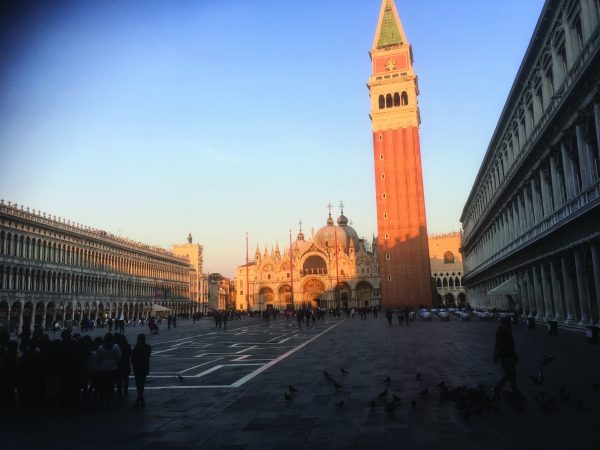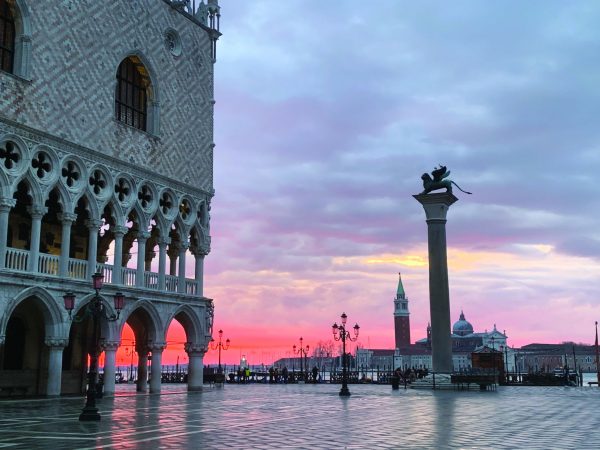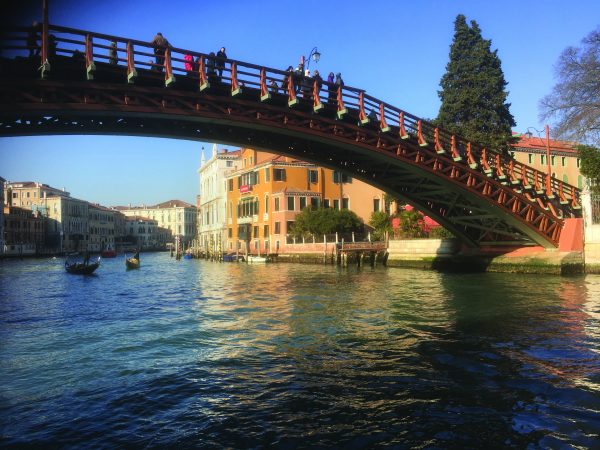Adrian Mourby ventures deep into San Marco, Venice’s oldest sestiere, which is known the world over for its piazza and yet is otherwise relatively rarely explored.
Images by Kate Tadman-Mourby unless otherwise stated
Of course we all know San Marco. This area of Venice has the best of the Grand Canal, the Rialto and Accademia Bridges, and Piazza San Marco itself. And it has the Mercerie, that long sequence of shopping streets that links the Rialto to the Basilica di San Marco. Over the centuries every tourist who fancied they could write stayed in this central district, or sestiere – and penned an opinion on it.
Yet San Marco is also complex and labyrinthine. Like a metaphor for Venice itself, it is glamorous and instantly recognisable on the surface, and yet obscure and unknowable once you step beyond the obvious.
First encounters
The way most of us first encounter Venice’s oldest sestiere is on the vaporetto, the water bus, down from Piazzale Roma or Ferrovia. It’s actually quicker to walk from the bus or train stations to Piazza San Marco, the very heart of Venice, but taking a vaporetto down the Grand Canal is the perfect way to discover that Venice can look exactly like Venice is supposed to look. Very few tourist sights are this kind to you.
The sestiere of San Marco starts just before the Rialto Bridge and solely on the left-hand, eastern shore of the Grand Canal. Its first building is quite magnificent: the Fondaco dei Tedeschi was rebuilt in the early 16th century as a caravanserai, a place where merchants, mostly German, arriving in the city could find lodgings and store their goods. With its sturdy stone walls and crenellations it resembles a fortress. Later it became Venice’s post office but now it is T Fondaco dei Tedeschi, the most glamorous shopping centre in Veneto. Luckily its monumental proportions and inner courtyard architecture remain intact.
After the Rialto Bridge the vaporetto chugs on past a muddled range of shops, hotels and vaporetto pontoons until a stately sequence of palazzi begins that runs all the way down to Piazza San Marco. Palazzo Dolfin Manin, now the headquarters of Banca d’Italia, is by the great architect Sansovino, with interiors by Tiepolo. The Dandolo family created a whole sequence of medieval palazzi here, and then there’s the monumental Palazzo Grimani by the 16th-century architect Michele Sanmicheli. It can sometimes be hard-going locating the landward entrances to these buildings. They were intended to be reached by gondola from the Grand Canal. Only servants and tradespeople arrived on foot.
The Palazzo Mocenigo is one of four palazzi by that family also lined up on this bank of the canal. The Mocenigo family gave Venice seven doges and built its palazzi on the biggest bend of the Grand Canal, one of which sports a plaque proclaiming that this was Lord Byron’s home in Venice in 1818-19.
Just before the Accademia Bridge rises Palazzo Giustinian Lolin, completed in the 15th century by Baldassare Longhena. The two obelisks on its roof indicate that there was an admiral or two in the family. After Accademia, Palazzo Barbaro – an amalgamation of two palazzi – was the home of the Barbaro Set in the 19th and early 20th centuries. Here the American Curtis family hosted Henry James, John Singer Sargent and Claude Monet. The poet Robert Browning, nearing the end of his life, used to come over from his son’s palazzo on the other side of the Grand Canal to visit. Mrs Patricia Curtis, great-granddaughter of the hugely hospitable Daniel Sargent Curtis, still lives on the top floor. She once kindly showed me the baroque library where Henry James slept and thought he was in heaven. James finished his novella The Aspern Papers in Palazzo Barbaro and it was here that he set The Wings of the Dove.
Further towards San Marco – and quite modest compared with its monumental neighbours, is Palazzo Barbarigo Minotto, like Barbaro another “amalgam palazzo”. Nightly opera performances are given here in a building which manages to gracefully combine 15th- and 18th-century styles. Then we come upon a sequence of palaces that have been turned into hotels. Prominent among them is the Gritti Palace built originally as Palazzo Pisani with vibrant 15th-century murals on its exterior by Giorgione (long since eroded). The St Regis Hotel was formerly the Grand Hotel Britannia and before that the private Palazzo Badoer Tiepolo. The Bauer Hotel viewed from the canal appears as if it too was also once a palace, but actually it was built in the 19th century, in the neo-Gothic style, as the Grunwald Hotel de Ville.
Soon we are at the low-rise Hotel Monaco & Grand Canal, where young Giuseppe Cipriani worked as a barman. Next to it is the 19th-century rope factory that he converted into Harry’s Bar with funds from an American customer called Harry Pickering.
What follows is the best-known section of San Marco: the Giardini Reali, which Napoleon’s stepson created by demolishing Venice’s old granaries; the city’s mint by Sansovino; Piazzetta San Marco, the most glamorous entry point into Venice and which all foreigners had to use; and finally the Doges’ Palace. As soon as you pass it, you are leaving the sestiere of San Marco. The Bridge of Straw (Ponte della Paglia), with its world-famous view of the Bridge of Sighs, marks where the sestiere of Castello begins.
The grand canal
The Grand Canal is a superb introduction to San Marco – and to Venice itself – but this is the most central of the six sestieri and walking inland opens up so many more possibilities. The Piazza (there is only one in Venice) is obviously a destination in its own right. Despite the instant familiarity we might feel on reaching it – this uneven, L-shaped public space seems to be in every guide book and on every poster for Italy – it is worth exploring for the remarkable sequence of buildings of which it is comprised. There is not a single building, decorative detail, or even a single flagpole in Piazza San Marco (and its smaller piazzetta in front of the Doges’ Palace) that doesn’t have both great architectural value and a fascinating history.
Beyond it, beginning below the blue and gold Torre dell’Orologio, runs a maze of shopping streets heading north towards Rialto. Each used to house a particular group of tradesmen. Now it’s known as the Mercerie (Haberdasheries) and is full of shops selling Murano glass, carnival masks, Alessi coffee pots and high-end fashion.
Look up to your left after the tower to see a memorial to Giustina Rossi, who in 1310 dropped a mortar and pestle from her window onto the flagbearer leading an insurrection towards the Doges’ Palace. The rebels scattered and she was rewarded with a promise that her rent would never be raised.
Zig Zag route
Turning one of the many corners on this zig-zag route, we come to the Church of San Zulian, its façade built by Sansovino and paid for by Dr Tommaso Rangone. The physician’s bronze seated statue appears above the door. He holds sarsaparilla and guaiacum in his hand; these plants were used to treat syphilis and yellow fever. By incorporating himself into the façade, Rangone got round a Venetian embargo on memorials to its citizens, and even created an advertisement for his skills.
Following signs Per Rialto we head along Calle delle Acque, where there is the half-hidden church of San Salvatore. At the time of its construction, in the 12th century, this area between San Marco and Rialto was marshland, but a vision of Jesus in a cloud of red dust appeared here, inspiring the construction of a monumental church. You access it up a flight of steps between two shop fronts. Suddenly the daily bustle of Venice disappears inside this monochrome vault containing memorials to a few doges. More noteworthy is the grave of Caterina Cornaro, who led such a tragic life that Donizetti wrote an opera about her. Born in Venice and married at the age of fourteen to the King of Cyprus, she was widowed soon after the wedding was solemnised, on her eighteenth birthday. She was then as good as compelled to hand over the island to her people. The memorial shows Caterina calmly presenting Cyprus to the Doge, but I suspect there was a crafty bit of realpolitik behind her marriage and sudden widowhood.
The church has a more ostentatious entrance facing onto Campo San Salvador. From here, the Campo San Bartolomeo is just a few footsteps past the Disney Shop. Here the statue of playwright Carlo Goldoni dominates the long rectangular public space, with the Rialto Bridge off to our left. There is a saying in Venice that “Everything happens in San Bartolomeo,” which means this was the place to swap gossip. Goldoni wrote comedies in the Venetian dialect that are still played in the city. One of them, The Servant of Two Masters, was recently presented to great acclaim in London as One Man, Two Guv’nors.
We have come full circle. The Fondaco dei Tedeschi is just behind the Goldoni statue. Since it was opened up as a shopping centre, the pantile roof terrace has been accessible to visitors, as long as they booked ahead online. Not only is there a wonderful aerial view down to Rialto from this roof, but in fact you can see all over the sestiere of San Marco. It’s a fitting place to end this tour and look back on all we have seen today.
Like this article? Discover more like it in our Venice archive!



